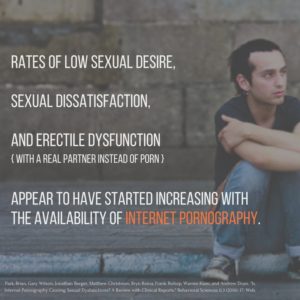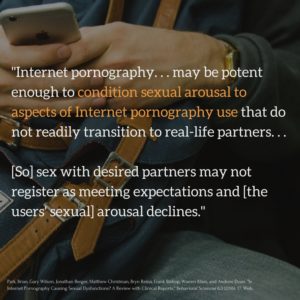[Note: this article contains medical discussion of sexual dysfunctions.]
A new paper investigating the harms of pornography has been published, and its findings are cause for concern.
A team of seven urologists, neuroscientists and psychiatrists from the Navy along with Gary Wilson, the founder of YourBrainOnPorn, set out to collect the facts, review research, and provide clinical case reports regarding the association between rising rates of sexual dysfunction in young men and their use of Internet pornography.
and psychiatrists from the Navy along with Gary Wilson, the founder of YourBrainOnPorn, set out to collect the facts, review research, and provide clinical case reports regarding the association between rising rates of sexual dysfunction in young men and their use of Internet pornography.
Their review, published in Behavioral Sciences, found that rates of sexual dysfunctions among young men have dramatically increased in recent years.
A statement by the team explained:
“For example, 15 years ago erectile dysfunction rates were negligible (2-5%) in
sexually active men under 40. Now, researchers are reporting rates as high as 30% in this same age group. Many of these men are able to attain erections and ejaculate when viewing porn, but experience sexual dysfunctions (difficulty climaxing, low sexual desire, sexual dissatisfaction, ED) during partnered sex.The rapid increase in sexual dysfunctions in men under 40 cannot be adequately explained by smoking, diabetes, obesity, or cardiovascular disease, factors commonly associated with such problems in older men. These factors have not increased proportionately. However, a major change in men’s sexual environment has been the advent of streaming porn at the end of 2006.”
Why would pornography cause these problems?
An in-depth analysis of extensive neuroscience research gave the authors a hypothesis.
 Porn users can become sexually triggered, or hyper-reactive, to porn-related cues. This can cause the motivational systems of the brain, which spur us to engage in activities like eating or having sex, to fixate on pornography in a way that results in real-life, partnered, sex failing to meet the users’ expectations.
Porn users can become sexually triggered, or hyper-reactive, to porn-related cues. This can cause the motivational systems of the brain, which spur us to engage in activities like eating or having sex, to fixate on pornography in a way that results in real-life, partnered, sex failing to meet the users’ expectations.
After all, how could one person in bed compete with Internet pornography’s endless novelty, voyeuristic perspective, and lack of boundaries regarding particular sex acts?
Real sex, then, registers in the brain as less arousing than Internet pornography. Even with a desired partner. And therefore, the team stated, “sexual centers of the brain may not produce adequate neurochemical response to attain and maintain an erection or climax without difficulty.”
Summarizing existing research, the Navy doctors noted:
“Research is showing that the younger the age at which men are first exposed to internet porn, the greater their preference for it over partnered sex, the less enjoyment they report from partnered sex, and the more porn they use. This suggests that today’s Internet porn may be conditioning sexuality in unanticipated ways, which in some men shows up as sexual dysfunctions during partnered sex and debilitating distress.”
The team of doctors is calling f or further research in this field. They also warn healthcare providers to exercise informed discretion when diagnosing unexplained sexual dysfunction in men under 40, and to always inquire if a patient is only able to maintain arousal with Internet pornography as opposed to touch alone.
or further research in this field. They also warn healthcare providers to exercise informed discretion when diagnosing unexplained sexual dysfunction in men under 40, and to always inquire if a patient is only able to maintain arousal with Internet pornography as opposed to touch alone.
You can read more about this review here:
Park, B, et al. Is Internet Pornography Causing Sexual Dysfunctions? A Review with Clinical Reports Behavioral Sciences; published 5 August 2016.





